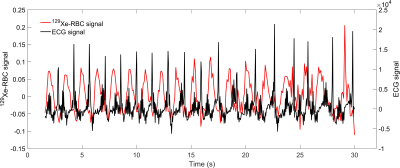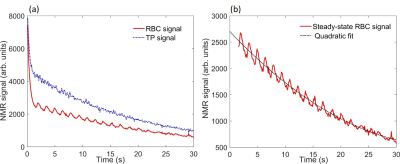Graham Norquay1, Guilhem J Collier1, and Jim M Wild1
1Infection, Immunity and Cardiovascular Disease, University of Sheffield, Sheffield, United Kingdom
1Infection, Immunity and Cardiovascular Disease, University of Sheffield, Sheffield, United Kingdom
- ECG was synchronised with global 129Xe MRS to temporally correlate 129Xe RBC signal dynamics with the cardiac cycle
- We found that positive and negative changes in the 129Xe-RBC signal amplitude occur during ventricular systole and diastole in a healthy volunteer.

Figure 4: The RBC signal (red line) is divided
by the fit in Fig. 2 (b) and subtracted by the mean signal value to obtain the
fractional signal change for RBC over time. Overlaid in black is the ECG signal
which was recorded during the MR acquisition. It is clear from the ECG overlay
that the RBC signal is at maximum and minimum during ventricular systole and
diastole, respectively.

